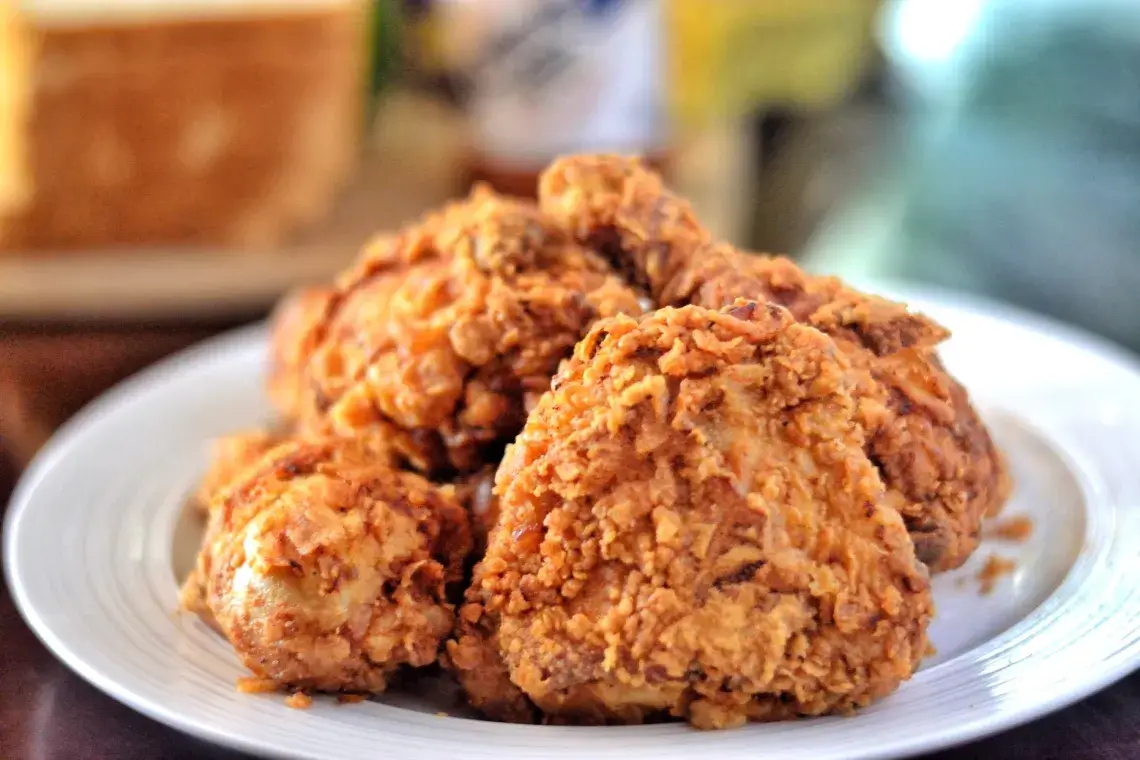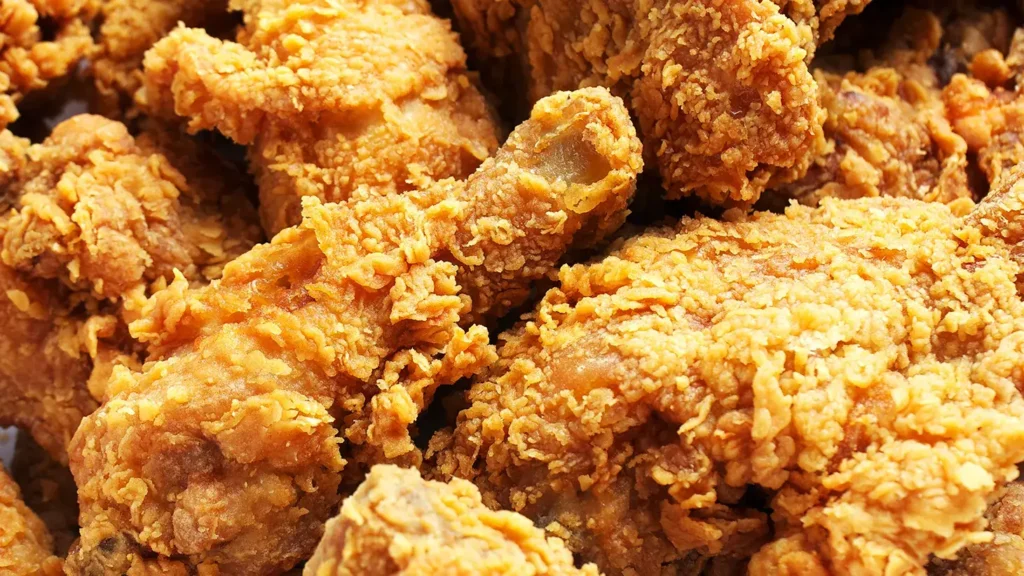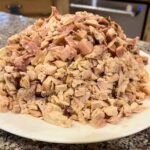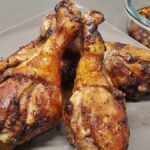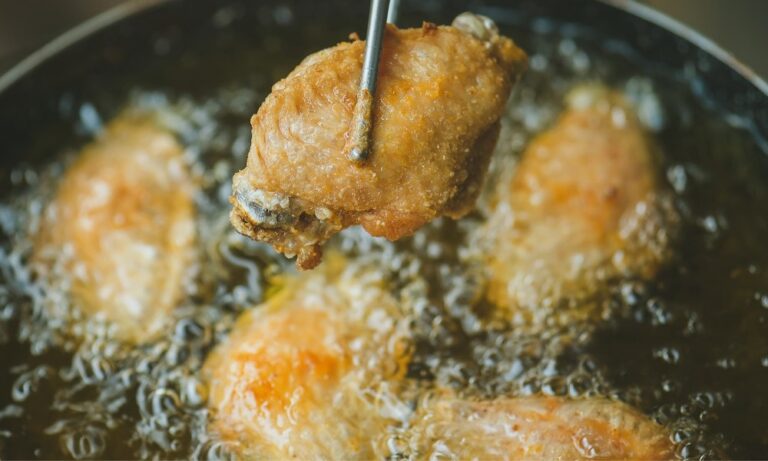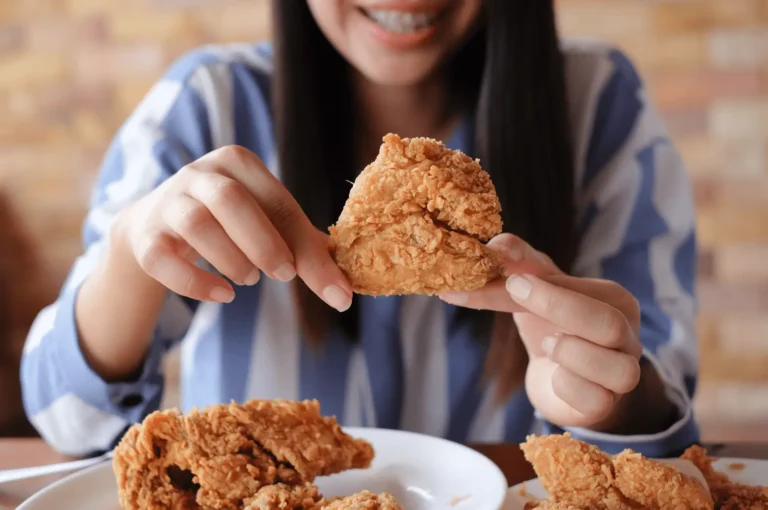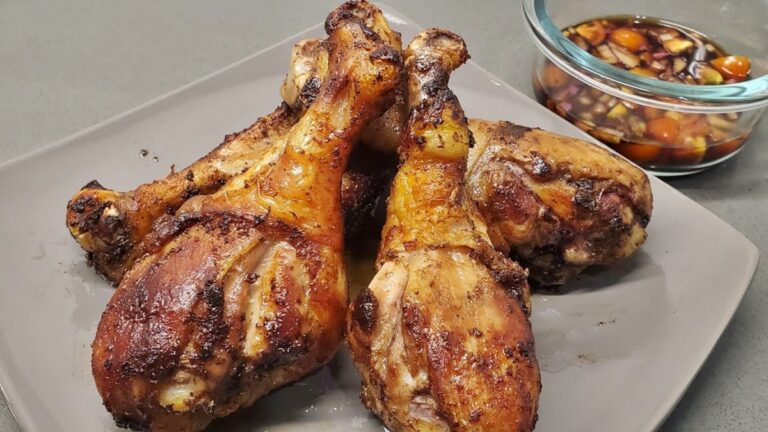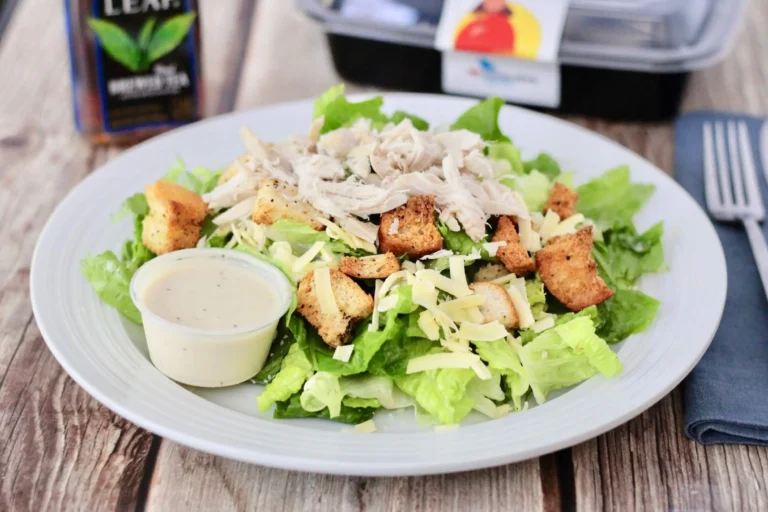Can You Use Self Rising Flour to Fry Chicken ?
Imagine sinking your teeth into a succulent piece of fried chicken – the crispy exterior giving way to juicy, flavorful meat.
But here’s the twist: can you achieve that same mouthwatering experience using self-rising flour? You may be wondering if this pantry staple can work its magic in the realm of fried chicken.
Well, let’s dive into the guide for Can You Use Self Rising Flour to Fry Chicken.
Contents
- 1 Key Takeaways
- 2 What Is Self-Rising Flour?
- 3 The Role of Flour in Fried Chicken
- 4 Can Self-Rising Flour Provide a Crispy Texture?
- 5 The Impact of Leavening Agents on Fried Chicken
- 6 Adjustments Needed When Using Self-Rising Flour
- 7 Alternative Flour Options for Frying Chicken
- 8 Best Practices for Frying Chicken With Self-Rising Flour
- 9 Frequently Asked Questions
- 9.1 Are There Any Health Benefits to Using Self-Rising Flour for Frying Chicken?
- 9.2 Can Self-Rising Flour Be Used for Other Types of Fried Foods, Like Onion Rings or Fried Pickles?
- 9.3 Can Self-Rising Flour Be Used for Gluten-Free Frying?
- 9.4 How Does the Use of Self-Rising Flour Affect the Cooking Time for Fried Chicken?
- 9.5 Are There Any Specific Brands of Self-Rising Flour That Are Recommended for Frying Chicken?
- 10 Conclusion – Can You Use Self Rising Flour to Fry Chicken
Key Takeaways
- Self-rising flour contains baking powder and salt, eliminating the need for adding leavening agents separately.
- All-purpose flour is commonly used for frying chicken, but different types of flour can yield varying results in texture.
- Adding ingredients like cornstarch or crushed cornflakes can enhance the crispiness of chicken when using self-rising flour.
- Adjusting the frying temperature and double coating the chicken can contribute to a crunchier exterior when using self-rising flour.
What Is Self-Rising Flour?
Self-rising flour is a versatile ingredient commonly used in baking, known for its ability to produce light and fluffy results without the need for additional leavening agents. But what exactly is self-rising flour and how is it different from all-purpose flour?
Self-rising flour is a type of flour that already contains the necessary leavening agents, such as baking powder and salt. This means that when you use self-rising flour, you don’t need to add these ingredients separately.
The key ingredients in self-rising flour are all-purpose flour, baking powder, and salt. All-purpose flour provides the base for the flour mixture, while baking powder acts as the leavening agent, helping the dough or batter rise. Salt adds flavor to the flour and helps to balance the taste.
The proportions of these ingredients in self-rising flour are carefully measured to ensure the best leavening properties. Typically, self-rising flour contains about 1 1/2 teaspoons of baking powder and 1/4 teaspoon of salt per cup of flour. These precise measurements guarantee that your baked goods will rise and have that light and fluffy texture we all love.
Now that you know what self-rising flour is and how it differs from all-purpose flour, you can confidently use it in your baking adventures. Enjoy the freedom of not having to worry about adding leavening agents separately, as self-rising flour has got you covered.
The Role of Flour in Fried Chicken
Flour plays a crucial role in the process of frying chicken, providing a protective coating that helps to seal in moisture and create a crispy exterior. When it comes to choosing the right flour for frying chicken, there are a few factors to consider. Different types of flour can yield varying results, so it’s important to understand their characteristics and how they affect the final product.
All-purpose flour is a common choice for frying chicken. It has a moderate protein content, which helps to create a light and crispy coating. However, if you prefer a thicker and crunchier crust, you can opt for a flour with higher protein content, such as bread flour or even a combination of all-purpose flour and cornstarch. These flours provide more structure and result in a heartier texture.
When it comes to frying techniques, it’s important to properly coat the chicken with flour. This can be done by first dredging the chicken in a seasoned flour mixture, then dipping it in beaten eggs or buttermilk, and finally coating it again with the flour mixture. This double coating ensures a thick and even crust.
Can Self-Rising Flour Provide a Crispy Texture?
To achieve a crispy texture in fried chicken, it’s important to explore the potential of self-rising flour. While self-rising flour can be a convenient option for coating your chicken, it may not provide the desired level of crispiness on its own. However, with the right techniques and additional ingredients, you can still achieve a crispy fried chicken using self-rising flour.
Here are some tips for achieving that perfect crunch:
-
Mix in other ingredients: To enhance the crispiness of your chicken, consider adding other ingredients to your self-rising flour mixture. Options like cornstarch, baking powder, or even crushed cornflakes can help create a more textured and crispy coating.
-
Double coat your chicken: For an extra crispy texture, try double coating your chicken. Dip the chicken in a well-seasoned buttermilk or egg mixture, then coat it in the self-rising flour mixture. Repeat the process to add an additional layer of coating, which will contribute to a crunchier exterior.
-
Adjust frying temperature: Maintaining the right oil temperature is crucial for achieving crispy fried chicken. Too low of a temperature can result in a greasy texture, while too high of a temperature can cause the chicken to burn. Aim for an oil temperature of around 350°F (175°C) for best results.
-
Consider alternative coating options: While self-rising flour can provide a decent level of crispiness, exploring alternative coating options can offer even better results. Experiment with ingredients like panko breadcrumbs, crushed crackers, or a combination of different flours to find the perfect coating for your fried chicken.
The Impact of Leavening Agents on Fried Chicken
Leavening agents play a significant role in determining the texture and overall quality of fried chicken. When it comes to frying chicken, the choice of leavening agent can greatly impact the end result. Leavening agents, such as baking powder and baking soda, are commonly used in breading mixtures to create a light and airy texture.
The effects of leavening agents on the breading texture of fried chicken are noteworthy. Baking powder, for instance, contains both an acid and a base, which react when combined with moisture and heat. This reaction produces carbon dioxide gas, resulting in a light and crispy texture. On the other hand, baking soda requires an acidic ingredient to activate its leavening properties. When used correctly, it can also contribute to a desirable breading texture.
It is important to note that the impact of leavening agents on fried chicken extends beyond just the breading. They can also affect the overall flavor profile. For instance, baking powder can lend a slightly tangy taste to the breading, while baking soda may contribute to a slightly bitter flavor if not properly balanced.
While leavening agents are commonly used in fried chicken recipes, they can also be found in other fried foods. For example, they’re often used in batter for fried fish or onion rings to create a light and crispy coating.
Adjustments Needed When Using Self-Rising Flour
When using self-rising flour to fry chicken, there are several adjustments that need to be made.
First, it’s important to ensure that the moisture content of the chicken is properly balanced to prevent a soggy or dry coating.
Additionally, the leavening agents in the self-rising flour may need to be adjusted to achieve the desired level of crispiness.
Lastly, the cooking time and temperature may need to be modified to ensure that the chicken is cooked through and the coating is golden brown.
Also read : Willie Mae’s Fried Chicken Recipe
Proper Moisture Content
For optimal results when using self-rising flour to fry chicken, it’s important to ensure the proper moisture content in your batter. Maintaining the right moisture content will help achieve a crispy and flavorful coating that adheres well to the chicken. Here are some adjustments you can make to achieve the ideal moisture content:
-
Control liquid ingredients: Carefully measure the amount of liquid you use in your batter. Too much liquid can make the batter runny, resulting in a soggy coating. Adjust the quantity as needed to achieve a thick but pourable consistency.
-
Add a binding agent: Incorporate an egg or a tablespoon of mayonnaise to help bind the ingredients together and create a thicker batter.
-
Adjust the flour-to-liquid ratio: If your batter is too thin, gradually add more self-rising flour until you reach the desired consistency. If it’s too thick, incorporate small amounts of liquid until it thins out.
-
Rest the batter: Letting the batter rest for 10-15 minutes allows the self-rising flour to fully hydrate and absorb the liquid, resulting in a better texture and improved moisture content.
Adjusting Leavening Agents
To achieve the best results when using self-rising flour to fry chicken, it’s important to make adjustments to the leavening agents in order to ensure the desired texture and taste. Self-rising flour already contains leavening agents, such as baking powder, which can affect the outcome of your fried chicken. Adjusting these agents is crucial to maintain the right balance.
The importance of proper moisture content must also be considered. When using self-rising flour, you may need to reduce the amount of additional baking powder or baking soda in your recipe. This will prevent the chicken from becoming overly puffy or dense.
Additionally, be mindful of the moisture content in your batter or coating. Too much moisture can lead to a soggy texture, while too little can result in dry and tough chicken. Experiment with different ratios until you achieve the desired crispiness and tenderness.
Also Find – Chicken in a Biskit Crackers Recipe
Cooking Time and Temperature
Are adjustments needed in cooking time and temperature when using self-rising flour to fry chicken? Absolutely. Self-rising flour contains leavening agents, which can affect the cooking process. Here are some key points to consider when it comes to cooking time and temperature with self-rising flour:
-
Cooking techniques: When frying chicken with self-rising flour, ensure that the oil is hot enough to create a crispy exterior. Monitor the temperature closely to prevent burning or undercooking.
-
Oil selection: Choose an oil with a high smoke point, such as vegetable or canola oil, to maintain a stable frying temperature. This will help the chicken cook evenly and prevent it from becoming greasy.
-
Adjusting cooking time: Self-rising flour may accelerate the browning process due to the presence of baking powder. Keep an eye on the chicken as it cooks and adjust the cooking time accordingly to avoid overcooking.
-
Testing for doneness: To ensure the chicken is fully cooked, use a meat thermometer to check the internal temperature. It should reach 165°F (74°C) for safe consumption.
Alternative Flour Options for Frying Chicken
Looking for alternative flour options to fry your chicken?
Gluten-free flours, such as rice flour or almond flour, can be excellent choices for those with dietary restrictions.
These flours not only provide a suitable substitute for traditional wheat flour, but they also offer added nutritional benefits like higher protein content and lower carbohydrate levels.
Consider trying out these alternative options to enhance the taste and healthiness of your fried chicken.
Also Read : Zippy’s korean fried chicken recipe
Gluten-Free Flour Options
For those seeking a gluten-free alternative for frying chicken, there are a variety of flour options available. Here are four gluten-free flour brands that you can use to fry chicken, along with some cooking techniques to ensure delicious results:
-
Bob’s Red Mill Gluten-Free All-Purpose Flour: This versatile flour blend is made from a combination of rice flour, potato starch, and tapioca flour. It works well for breading chicken and provides a crispy texture.
-
Cup4Cup Gluten-Free Flour: Developed by renowned chef Thomas Keller, this flour is a one-to-one replacement for all-purpose flour. It creates a light and crispy coating, perfect for frying chicken.
-
King Arthur Gluten-Free Flour: This flour blend is made from a combination of rice flour, tapioca starch, and potato starch. It produces a golden, crispy crust when used to fry chicken.
-
Pamela’s Products Gluten-Free Artisan Flour Blend: This flour blend is made from a combination of brown rice flour, tapioca starch, and almond meal. It adds a nutty flavor to fried chicken and creates a crispy coating.
When using gluten-free flour for frying chicken, it’s important to follow these cooking techniques:
-
Ensure the chicken is dry before coating it in flour to prevent clumping.
-
Dip the chicken in beaten egg or buttermilk before coating it with flour to help the breading adhere.
-
Fry the chicken in hot oil at the right temperature (around 350°F) to achieve a crispy exterior and juicy interior.
Nutritional Benefits of Alternative Flours
To further explore the world of gluten-free flour options for frying chicken, let’s now examine the nutritional benefits of alternative flours. Alternative flours not only provide a gluten-free option for those with dietary restrictions, but they also offer various health benefits. Take a look at the table below for a comparison of the nutritional content of some popular alternative flours:
| Alternative Flour | Protein (g) | Fiber (g) | Iron (mg) | Calcium (mg) | Calories (per 100g) |
|---|---|---|---|---|---|
| Almond Flour | 21 | 11 | 3.7 | 240 | 610 |
| Coconut Flour | 19 | 39 | 2.8 | 57 | 354 |
| Chickpea Flour | 21 | 6 | 4.7 | 105 | 387 |
| Rice Flour | 7 | 1 | 0.8 | 9 | 366 |
| Quinoa Flour | 13 | 4 | 5.2 | 47 | 368 |
As you can see, these alternative flours offer a range of nutritional benefits, including high protein and fiber content. Additionally, they provide essential minerals such as iron and calcium. Incorporating these gluten-free options into your fried chicken recipes can not only cater to those with dietary restrictions but also contribute to a healthier and more diverse diet.
Also Read : Watermelon Fried Chicken Recipe
Best Practices for Frying Chicken With Self-Rising Flour
To achieve perfectly fried chicken using self-rising flour, follow these best practices for optimal results:
-
Choose the best oil for frying chicken:
When it comes to frying chicken with self-rising flour, it’s important to select the right oil. Opt for oils with a high smoke point, such as vegetable, canola, peanut, or sunflower oil. These oils can withstand the high temperatures required for frying without breaking down or imparting unwanted flavors. -
Seasoning options for fried chicken:
While self-rising flour already contains salt and leavening agents, you may want to enhance the flavor of your fried chicken with additional seasonings. Consider adding spices like paprika, garlic powder, onion powder, cayenne pepper, or dried herbs to the flour mixture. Experiment with different combinations to create a flavor profile that suits your preferences. -
Preheat the oil to the right temperature:
Before frying the chicken, make sure the oil is heated to the correct temperature. Aim for around 350-375°F (175-190°C) to ensure crispy and evenly cooked chicken. Using a thermometer is the most accurate way to determine the oil’s temperature. -
Follow proper frying techniques:
To achieve the best results, coat the chicken pieces in self-rising flour, shaking off any excess before frying. Place the chicken carefully into the hot oil, being cautious of any splattering. Fry the chicken until it reaches an internal temperature of 165°F (74°C) and the coating turns golden brown. Drain the fried chicken on a wire rack or paper towels to remove excess oil.
Frequently Asked Questions
Are There Any Health Benefits to Using Self-Rising Flour for Frying Chicken?
Using self-rising flour to fry chicken does not provide any specific health benefits or enhanced nutritional value. It primarily acts as a convenient option for those who want to simplify the frying process.
Can Self-Rising Flour Be Used for Other Types of Fried Foods, Like Onion Rings or Fried Pickles?
Yes, you can use self-rising flour for frying chicken. It creates a crispy and flavorful crust. Additionally, it can be used for other fried foods like onion rings and fried pickles. Experiment with it for fish and chips or fried vegetables. Enjoy the freedom of culinary creativity!
Can Self-Rising Flour Be Used for Gluten-Free Frying?
Yes, you can use self-rising flour for gluten-free frying. However, there are alternative flour options such as rice flour or almond flour that may be better suited for a gluten-free diet.
How Does the Use of Self-Rising Flour Affect the Cooking Time for Fried Chicken?
Using self-rising flour for frying chicken impacts the texture, resulting in a crispy and airy crust. Compared to traditional flour, it cuts down the cooking time due to the added leavening agents. Enjoy the freedom of quick and delicious fried chicken.
Are There Any Specific Brands of Self-Rising Flour That Are Recommended for Frying Chicken?
When frying chicken, there are recommended brands of self-rising flour that can be used. However, if you prefer alternatives, you can also use all-purpose flour with baking powder and salt.
Conclusion – Can You Use Self Rising Flour to Fry Chicken
While it may seem counterintuitive, using self-rising flour to fry chicken can actually result in a less crispy texture.
The leavening agents in self-rising flour can cause the coating to become thicker and more cake-like, rather than the desired crispy and golden crust.
It’s best to stick with traditional flour or consider alternative options like cornstarch or panko breadcrumbs for a truly crispy fried chicken experience.
